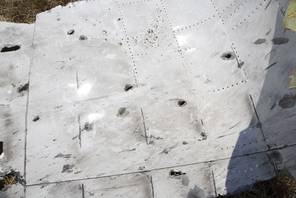Dutch Safety Board (DSB) Report: Malaysian MH17 was Brought Down by “A Large Number of High Energy Objects”, Contradicts US Claims that it Was Shot Down by a “Russian Missile”

According to the Dutch Safety Board (DSB) Report:
“Flight MH17 with a Boeing 777-200 operated by Malaysia Airlines broke up in the air probably as the result of structural damage caused by a large number of high-energy objects that penetrated the aircraft from outside.” (emphasis added)
While the report does not identify the nature of the “high energy objects”, the assessment suggests that the plane was perforated by “a large number” of unspecified projectiles or “bullets”.
This preliminary assessment including photographic evidence does not suggest that the plane was hit by “one or more” missiles, which is Washington’s official version. As we recall, Western governments as well as the mainstream media blamed both Moscow and “the Russian-backed rebels” and claimed, without a shred of evidence, that a Russian-made Buk missile was responsible for the plane crash.
These allegations were then used as a pretext to justify a series of tough economic sanctions against Russia.
An important question emerges: In the light of the DSB report findings, will president Obama retract his accusations directed against the Russian Federation?
The photographic evidence indicating machine gun like perforations (“numerous small holes”) suggest that the plane was hit by a military aircraft:
As yet it has not been possible to conduct a detailed study of the wreckage. However, the available images show that the pieces of wreckage were pierced in numerous places. The pattern of damage to the aircraft fuselage and the cockpit is consistent with that which may be expected from a large number of high-energy objects that penetrated the aircraft from outside. It’s likely that this damage resulted in a loss of structural integrity of the aircraft, leading to an in-flight break up. This also explains the abrupt end to the data registration on the recorders, the simultaneous loss of contact with air traffic control and the aircraft’s disappearance from radar.
“The initial results of the investigation point towards an external cause of the MH17 crash. More research will be necessary to determine the cause with greater precision. The Safety Board believes that additional evidence will become available for investigation in the period ahead.”
“The preliminary report issues the first findings in a ongoing investigation. From this point on, the investigation team will be working towards producing its final report. The Board aims to publish this report within one year of the date of the crash.” (DSB, op cit)
There is no mention in the DSB report of damage caused by a missile. The word “missile” does not appear in the press release. Moreover, the DSB –which was no doubt under political pressure– fails to clearly identify the nature of the “high-energy objects” which penetrated the aircraft.
It should be noted that the DSB findings are consistent with those of the OSCE head of mission who confirmed the existence of what he described as “machine gun like holes” (Wall Street Journal, July 31, 2014)
CBC Interview with OSCE observer monitor
They are also consistent with the earlier analysis of German Pilot Peter Haisenko published by Global Research:
The facts speak clear and loud and are beyond the realm of speculation: The cockpit shows traces of shelling! You can see the entry and exit holes. The edge of a portion of the holes is bent inwards. These are the smaller holes, round and clean, showing the entry points most likely that of a 30 millimeter caliber projectile.
This aircraft was not hit by a missile in the central portion. The destruction is limited to the cockpit area. (See Peter Haisenko, Revelations of German Pilot: Shocking Analysis of the “Shooting Down” of Malaysian MH17. “Aircraft Was Not Hit by a Missile”, anderweltonline.com in German, Global Research, July 30, 2014.)
Media Distortions
In a twisted logic, several mainstream media have intimated that the DSB findings pertaining to the “large number of high-energy objects” which penetrated the aircraft confirm “the suspicion that the plane was brought down by a BUK surface-to-air missile, which breaks into shrapnel shortly before it hits its target.” It is unfortunate that the Prime Minister of Malaysia has endorsed this biased interpretation and has signified that the DSB’s preliminary report suggests that the MH17 was downed a surface to air missile.
While there is evidence of perforations resulting from shrapnel, the small perforations are machine gun like bullet holes pointing to an attack by a military aircraft. These holes could not have been caused by a missile explosion as hinted by the MSM in its coverage of the DSB report.
Global Research will provide further analysis on this report in the coming days.
Below is Text of the Dutch Safety Board (DSB) Press Release as well links to the complete Dutch Security Board Report
The Full DSB Report is available online at
http://www.onderzoeksraad.nl/uploads/phase-docs/701/b3923acad0ceprem-rapport-mh-17-en-interactief.pdf
Click here for press release
DSB PRESS RELEASE
Preliminary report points towards external cause of MH17 crash
No evidence of technical faults
Flight MH17 with a Boeing 777-200 operated by Malaysia Airlines broke up in the air probably as the result of structural damage caused by a large number of high-energy objects that penetrated the aircraft from outside. This is mentioned in the preliminary report on the investigation into the crash of MH17 that has been published today by the Dutch Safety Board. There are no indications that the MH17 crash was caused by a technical fault or by actions of the crew.
The cockpit voice recorder, the flight data recorder and data from air traffic control all suggest that flight MH17 proceeded as normal until 13:20:03 (UTC), after which it ended abruptly. A full listening of the communications among the crew members in the cockpit recorded on the cockpit voice recorder revealed no signs of any technical faults or an emergency situation. Neither were any warning tones heard in the cockpit that might have pointed to technical problems. The flight data recorder registered no aircraft system warnings, and aircraft engine parameters were consistent with normal operation during the flight. The radio communications with Ukrainian air traffic control confirm that no emergency call was made by the cockpit crew. The final calls by Ukrainian air traffic control made between 13.20:00 and 13.22:02 (UTC) remained unanswered.
The pattern of wreckage on the ground suggests that the aircraft split into pieces during flight (an in-flight break up). Based on the available maintenance history the airplane was airworthy when it took off from Amsterdam and there were no known technical problems. The aircraft was manned by a qualified and experienced crew.
Pattern of damage
As yet it has not been possible to conduct a detailed study of the wreckage. However, the available images show that the pieces of wreckage were pierced in numerous places. The pattern of damage to the aircraft fuselage and the cockpit is consistent with that which may be expected from a large number of high-energy objects that penetrated the aircraft from outside. It’s likely that this damage resulted in a loss of structural integrity of the aircraft, leading to an in-flight break up. This also explains the abrupt end to the data registration on the recorders, the simultaneous loss of contact with air traffic control and the aircraft’s disappearance from radar.
Further investigation
In its preliminary report, the Safety Board presents the initial findings of an investigation that is still fully underway. More research will be necessary to determine more precisely what caused the crash and how the airplane disintegrated. The Board believes that additional evidence will become available in the period ahead. From this point on, the research team will start working towards producing the definitive investigation report. The Board aims to publish the report within one year of the date of the crash.
Procedure
The draft preliminary report has been sent to the Accredited Representative of the states that participate in the investigation (Malaysia, Ukraine, the Russian Federation, the United Kingdom, the United States of America and Australia) for review. All Accredited Representatives have sent a reaction. The Dutch Safety Board assessed the provided suggestions and amended the report where appropriate.
Tjibbe Joustra, Chairman of the Dutch Safety Board
“The MH17 crash has shocked the world and raised many questions. The Dutch Safety Board wishes to determine the cause of the crash, for the sake of the loved ones of the victims and for society at large.”
“The initial results of the investigation point towards an external cause of the MH17 crash. More research will be necessary to determine the cause with greater precision. The Safety Board believes that additional evidence will become available for investigation in the period ahead.”
“The preliminary report issues the first findings in a ongoing investigation. From this point on, the investigation team will be working towards producing its final report. The Board aims to publish this report within one year of the date of the crash.”



